Adromischus phillipsiae
Adromischus phillipsiae (Marloth) Poelln.
Family: Crassulaceae
Common names: bell-nenta (Eng.), klokkiesrosie, klokkiesnenta (Afr.)
Introduction
The bell-nenta is a succulent plant growing along the western mountainous escarpment margin between Sutherland and Steinkopf in the Western and Northern Cape. The plants are rosette-forming, with succulent leaves and stems, the leaves green to purplish mottled. It flowers in late summer or autumn, producing a tall inflorescence with conspicuous, orange-red to rarely yellowish, tubular, bell-shaped flowers. Best grown in containers.
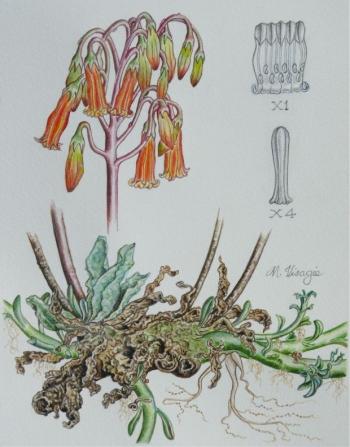
Fig. 1. An illustration of Adromischus phillipsiae by Marieta Visagie, from plants near Calvinia.
Description
Description
Adromischus phillipsiae plants are dwarf-sized, rosulate succulents, prolific from the base, solitary at first, with subterranean stolons forming small mats, sometimes on sheer cliffs, the clusters up to 200 mm in diameter and consisting of many heads. Rosettes are about 20-60 mm in diameter. Branches flaccid. Leaves, up to 8, ascending-spreading to almost horizontal, firm but softly succulent, oblanceolate elliptic, 15-20 x 5-13 mm, the base cuneate (wedge-shaped), the tip rounded; upper side concave or channelled, lower surface rounded, surface smooth, green, purplish mottled, the lower surface often purplish; margin entire. Inflorescence a thyrse, with 1-4 clusters (monochasia) each with 1-5 tubular flowers in the upper third. The flower (corolla) narrowly tubular, orange-red (rarely yellowish), funnel-shaped, 18-20 mm long, ending in 5 triangular-ovate, spreading lobes, 3-5 mm long. Seed small, wind dispersed. Flowering is mainly in autumn (March to April in the southern hemisphere).

Fig. 2. Adromischus phillipsiae filling a crevice on the sheer south facing cliff south-east of Calvinia.
Conservation Status
Status
Classified as Rare in the Red List of South African Plants (Raimondo et al. 2009). It is not common and has a small population but faces no known threats.
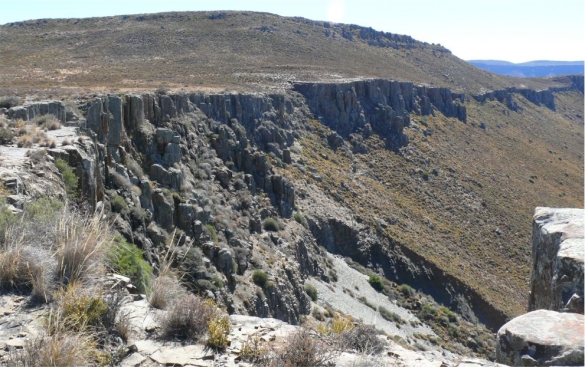
Fig. 3. The escarpment mountains west of Calvinia, Northern Cape. Adromischus phillipsiae grows on the rocky plateau above the cliff face.
Distribution and habitat
Distribution description
Adromischus phillipsiae is confined to the Escarpment Mountains between Verlatenkloof Pass near Sutherland in the Western Cape and northwards to Steinkopf in the Northern Cape. It grows in rocky regions, often on steep slopes and cliffs. When associated with rocky regions away from the cliff, it usually grows below karoo shrubs where it is well camouflaged. It also grows on difficult to reach, sheer cliffs. The substrate varies from mud-rock, sandstone and shale (Adelaide subgroup, Beaufort Group of the Karoo Supergroup) (Johnson et al. 2006).
Rainfall in its habitat occurs mainly during autumn, winter and spring, ranging from 100-150 mm per annum, mainly as cyclonic winter rain, with occasional thunder showers during spring or autumn. The summers are hot with temperatures frequently above 30°C. The winters are cold with frost and occasional snow especially along the southern section of its distribution.
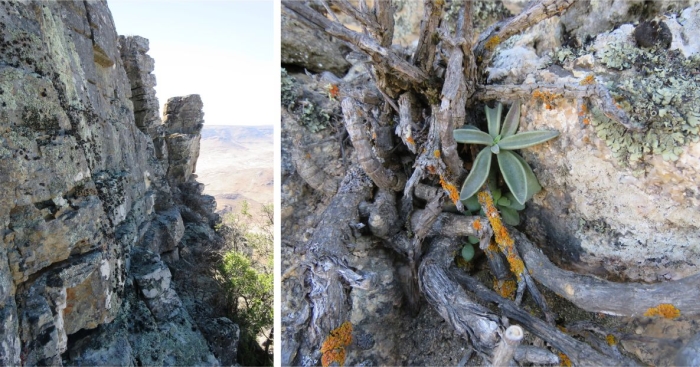
Fig. 4. A south-facing cliff face north west of Steinkopf where Adromischus phillipisiae was discovered by Florent Grenier, and a close-up of Adromischus phillipsiae growing at the base of a species of Mitrophyllum in shade on the cliff.
Near Steinkopf, in its northernmost habitat, Adromischus phillipsiae grows on cooler, south-facing cliffs among lichens, towards the mountain tops which receive frequent fog. Its shares its habitat with succulents such as Crassula tomentosa, Crassula elegans, Mitrophyllum sp. and a yellow flowered species of Conophytum.

Fig. 5. A small cluster of Adromischus phillipsiae growing with Crassula tomentosa on a south-facing cliffs north-west of Steinkopf, the numerous lichens are an indication of fog and dew.
On the escarpment mountains south-east of Calvinia, it grows on sheer cliffs together with a species of Adromischus, a pendent cluster-forming species of Crassula (cf C. lasiantha), Asplenium cordifolium and Haemanthus coccineus.

Fig. 6. Adromischus phillipsiae growing with Crassula lasiantha on a sheer cliff south-east of Calvinia.
West of Calvinia, Adromischus phillipsiae was found on top of the plateau growing in small clusters below Pteronia incana and other low growing karoo shrubs, at an altitude of about 1 600 m above sea level. The soil consists of fragments of mudstone. The plants grow close to the ground, forming compact tufts; they produce lateral subterranean branches to form new rosettes where they protrude from the leaf litter. When not in flower, plants are very difficult to detect below the shrublets. Other succulents commonly encountered in this habitat include Crassula muscosa, Crassula tetragona subsp. connivens, Stomatium pyrodorum (particularly on sand-filled bedrock), Crassula deltoidea, Cotyledon orbiculata and Tylecodon wallichii.
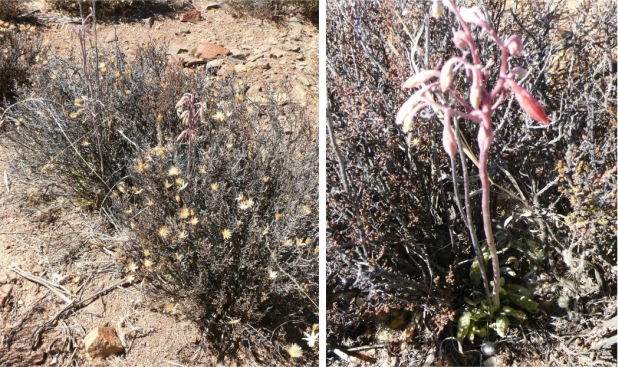
Fig. 7. A cluster of Adromischus phillipsiae growing below a nurse shrub, Pteronia incana in this instance, on a mudstone plateau west of Calvinia (Northern Cape), its leaves are well camouflaged underneath the nurse shrub and its colourful orange-red flowers protrude above it to attract the attention of sunbirds, the main pollinator.
Derivation of name and historical aspects
History
Adromischus phillipsiae was named by Rudolph Marloth (1855–1931) in 1907 in the Transactions of the South African Philosophical Society. Marloth was a well-known pharmacist and botanist from the University of Stellenbosch. He named his new species for Lady Dorothea Phillips (née Ortlepp, 1863–1940), the wife of the politician Sir Lionel Phillips, who encouraged the Parliament in establishing Kirstenbosch National Botanical Garden in 1913. Lady Phillips was a patron of arts and science and commissioned Marloth to write a book on South African wild flowers (Marloth 1907; Gunn & Codd 1981), which led to his famous Flora of South Africa of six volumes, appearing between 1913 and 1926. Marloth collected this species in March 1906 along the southern Roggeveld Mountains (Verlatenkloof Pass) at an altitude of 1 500 m.
Adromischus phillipsiae is one of six species of Adromischus that belong to section Brevipedunculati. This section was established by Carl von Poellnitz in 1940 to accommodate those species characterised by, glaucous-green (rarely pink or orange), funnel-shaped corolla tubes that are slightly grooved at their ends, and with minute club-shaped hairs on the inner surfaces of lobes and throats. Adromischus phillipsiae is immediately distinguished from all other species of Adromischus by its conspicuous orange-red (rarely yellow) flowers, almost resembling a species of Cotyledon and the reason why Marloth originally (1907) named it as a species of Cotyledon (C. phillipsiae). Von Poellnitz however, in 1940, rightfully transferred it to Adromischus.
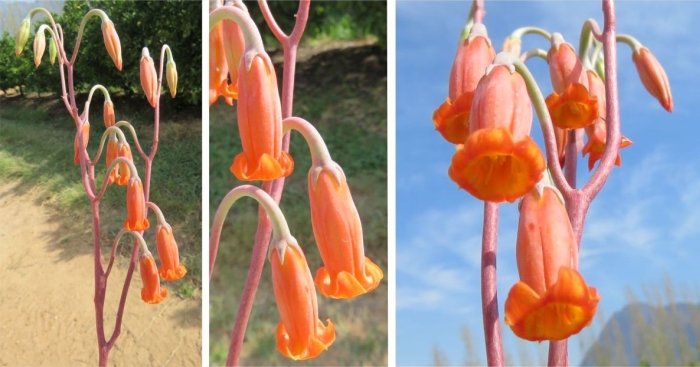
Fig. 8. The orange-red tubular flowers of Adromischus phillipsiae, on plants in cultivation at Babylonstoren Farm.
Within section Brevipeduculati there are three species which are closely related and all are confined to the southern and southwestern margin of the Great Escarpment. These include A. phillipsiae (western Escarpment), A. humilis (southwestern Escarpment) and A. fallax (southeastern Escarpment). They are at once recognized by their soft leaves (often purplish mottled) in basal rosettes and subterranean stolons, forming tight to loose, spreading clusters. Adromischus humilis is the smallest of the three. These three species are also difficult to root from leaf cuttings, unlike other species of Adromischus .
The genus Adromischus was established in 1852 by the botanist Lemaire. It belongs to the Crassulaceae family.
The depicted plants were photographed near Calvinia as well as Steinkopf, the northernmost location, the latter which was discovered by the intrepid French student, Florent Grenier. Florent also discovered a population of Adromischus phillipisae on cliffs south-east of Calvinia, accompanying the author to this site.
Ecology
Ecology
Adromischus phillipsiae proliferates from subterranean stolons forming dense clusters. The leaves are ascending-spreading, in tight rosettes. The swollen nature of the leaves, stems and roots reflects their ability to store moisture on the extreme, well-drained rocky and cliff-face habitats. When growing below shrubs, its well-camouflaged nature ensures that it is protected from most herbivores. The stolons will remain alive, even when faced with fire or grazing, and simply re-sprout.
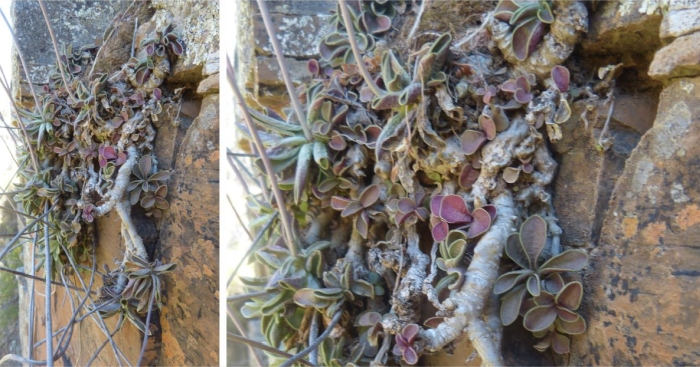
Fig. 9. A large cluster of Adromischus phillipsiae growing on a sheer south-facing cliff south-east of Calvinia. Note the numerous persistent dry flowers stalks.
The leaves are green to slightly greyish green, becoming purplish green with dry and cold conditions. Plants are long-lived, with leaves withering from the base. The leaves are soft and unarmed, lacking the horny stiff margin of most other species of Adromischus. The stoloniferous nature enables a vegetative propagation back-up, colonising new crevices, thus maximising its long-term survival.
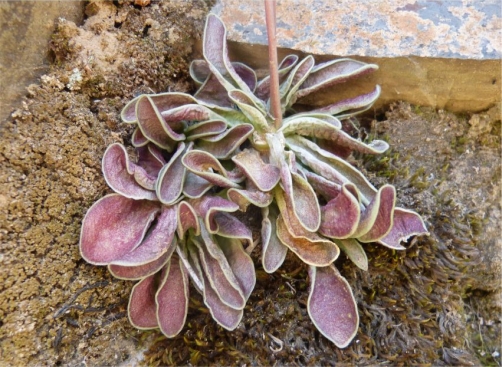
Fig. 10. A cluster of Adromischus phillipsiae growing in a crevice on the Escarpment cliffs south-east of Calvinia, the leaves purplish-mottled and deeply channelled during a dry period.
The inflorescence grows ascending to spreading, when not on cliffs protruding above the canopy of the nurse plants. The conspicuous orange-red (rarely yellow) corolla attracts malachite and other sunbirds which are the pollinators. It is the only species in the genus which is sunbird pollinated. The capsules release the seeds during winter, coinciding with the winter rainfall. Moisture in the soil is retained longer during this cooler time of the year thus providing the best chance of germinating. The seed is small and ideal for establishment in crevices. The seed is light, angular and shaken from the capsules, and dispersed by wind.

Fig. 11. Adromischus phillipsiae starting to flower (in bud), growing in a crevice on a shady south-facing vertical cliff face.
Uses
Use
No medicinal or cultural uses have been recorded. Plants are usually easily grown and are becoming popular pot plants in cultivation (Pilbeam et al 1998).

Fig. 12. Adromischus phillipsiae in cultivation at Babylonstoren Farm growing in a ceramic container. The leaves arranged in a basal rosette.
Growing Adromischus phillipsiae
Grow
Adromischus phillipsiae grows best in dappled shade, in a sandy-loam to loamy soil, with water in autumn, winter and spring but keep dry during summer. When watering, an organic fertiliser can be added. Plants adapts well to containers. Best for Karoo gardens and rockeries (Van Jaarsveld 2020).
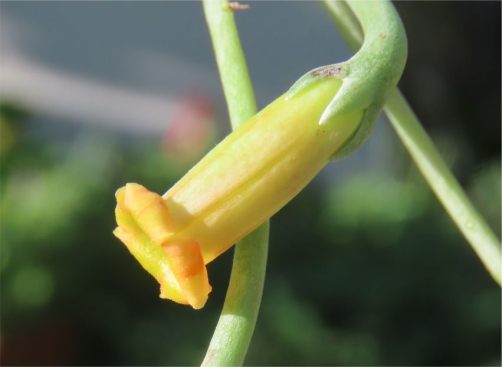
Fig. 13. A yellow flowered Adromischus phillipsiae in cultivation at Babylonstoren Farm collected by Florent Grenier on the Kamiesberg, Namaqualand.
In regions outside of its habitat ceramic containers are the solution. Grow in a gravely or sandy soil, ensuring good drainage. Keep in dappled shade. Plants are easily propagated by cuttings or dividing the clusters. Avoid too much watering as plants tend to rot. Water should be provided from autumn to spring.
Sow seed in winter or spring in a shallow tray in a sandy mixture and keep moist. Germination is within 3 weeks and once large enough to handle, transfer to individual containers. Place container in a shady position but with full light. The south side of a building is ideal.
Plants are relatively disease free (except for root rot caused by too much watering) but aphids, wine weevils, slugs and snails can sometimes be a problem.
References
- Gunn, M. & Codd, L.E. 1980. Botanical exploration of southern Africa. Balkema, Cape town.
- HEYWOOD, V.H. (ed.). 1978. Flowering plants of the world. Oxford University Press, Oxford, London, Melbourne.
- Johnson, M.R., et al. 2006. Sedimentary rocks of the Karoo Supergroup. In M.R. Johnson, C.R. Anhaeusser & R.J. Thomas (eds), The geology of South Africa: 463–501. Geological Society of South Africa, Johannesburg Council for Geoscience, Pretoria.
- Marloth, H.W.R. 1907. Some new South African succulents. Transactions of the South African Philosophical Society 18: 46.
- Mucina, L. & Rutherford, M.C. (eds) 2006. The vegetation of South Africa, Lesotho and Swaziland. Strelitzia 19. South African National Biodiversity Institute, Pretoria.
- Pilbeam, J., Rodgerson, C. & Tribble, D. 1998. Adromischus. The Cactus File Handbook 3. Cirio Publishing Services, Southampton.
- Raimondo, D., Von Staden, L., Foden, W., Victor, J.E., Helme, N.A., Turner, R.C., Kamundi, D.A. & Manyama, P.A. (eds) 2009. Red list of South African plants. Strelitzia 25. South African National Biodiversity Institute, Pretoria.
- Tölken, H.R. 1985. Crassulaceae. In: O.A. Leistner (ed). Flora of southern Africa 14(1):1-244. Botanical Research Institute, Pretoria.
- Van Jaarsveld, E.J. 2010. Waterwise gardening in South Africa and Namibia. Struik, Cape Town.
- Von Poellnitz, K. 1940. Zur Kenntnis der Gattungen Cotyledon L. und Adromischus Lem. Feddes repertorium specierum novarum regni vegetabilis, Zeitschrift für systematische Botanik 48: 80–113.
- Victor, J.E., Desmet, P.G., Bruyns, P.V. & Burgoyne, P.M. 2005. Adromischus phillipsiae (Marloth) Poelln. National Assessment: Red List of South African Plants version 2020.1. Accessed on 2023/01/28.
Credits
Ernst van Jaarsveld
Kirstenbosch National Botanical Garden (Retired 2015)
Babylonstoren Farm
Extraordinary senior lecturer and researcher,
Department of Biodiversity and Conservation, University of the Western Cape
January 2023
Acknowledgements: the author is thankful to Florent Grenier for assistance in the field and for accompanying him to the location southeast of Calvinia in the Northern Cape.
Plant Attributes:
Plant Type: Succulent
SA Distribution: Northern Cape, Western Cape
Soil type: Loam
Flowering season: Autumn
PH: Acid, Neutral
Flower colour: Red, Yellow, Orange
Aspect: Shade, Morning Sun (Semi Shade)
Gardening skill: Easy
Special Features:
Horticultural zones







Rate this article
Article well written and informative
Rate this plant
Is this an interesting plant?
Login to add your Comment
Back to topNot registered yet? Click here to register.